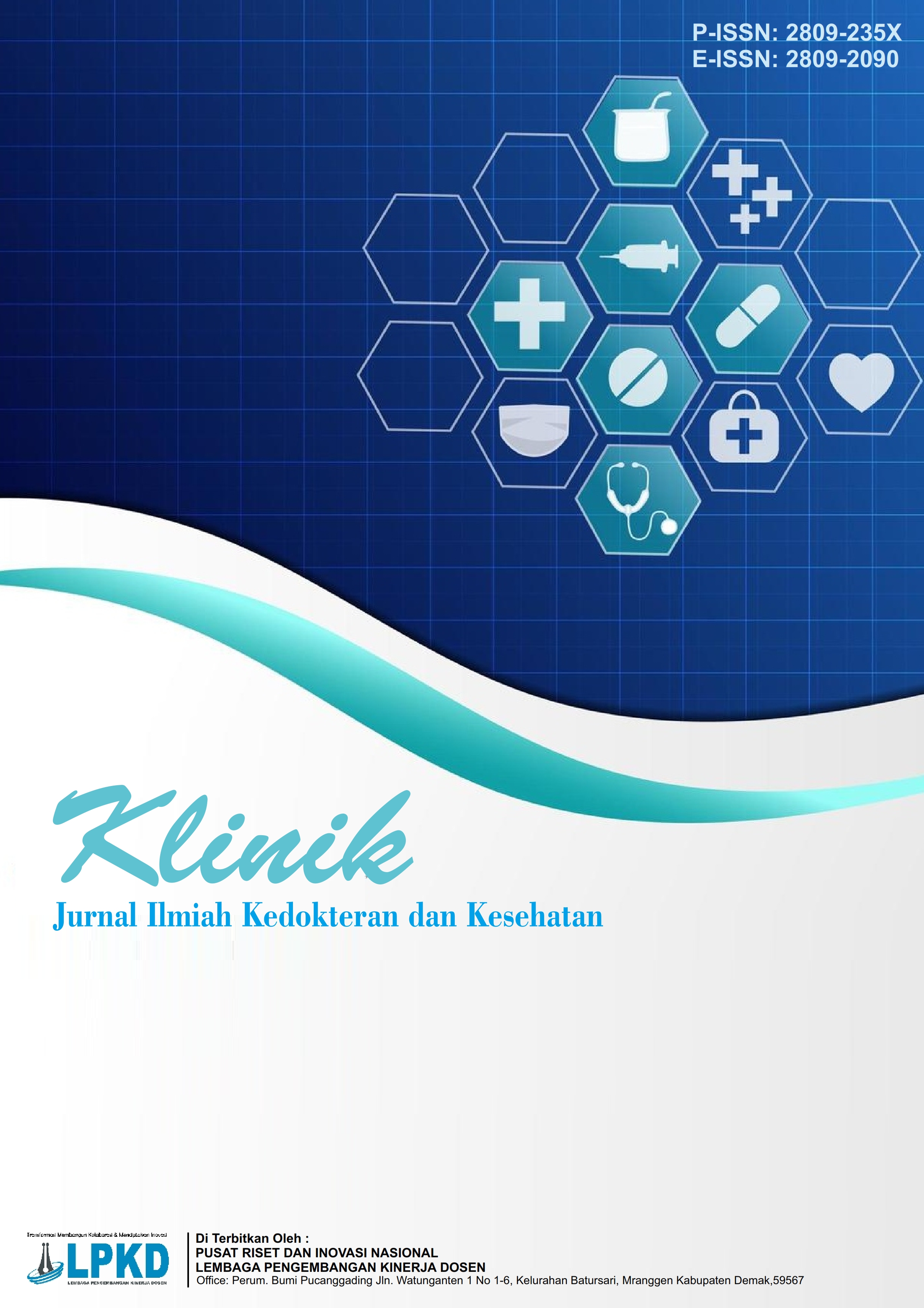Faktor-faktor yang Memengaruhi Kejadian Preeklampsia di RS Bhayangkara Polda Riau Provinsi Riau Tahun 2024
DOI:
https://doi.org/10.55606/klinik.v4i1.3984Keywords:
Age, Gestational Age, Parity, PreeclampsiaAbstract
The number of maternal deaths based on documentation of the family health program at the Ministry of Health, Indonesia had 4,627 deaths in 2020. This figure increased compared to 2019 which amounted to 4,221 deaths. Based on the cause, most maternal deaths in 2020 occurred due to bleeding (1,330 cases), pregnancy-related hypertension (1,110 cases), and circulatory system disorders (230 cases). Preeclampsia is associated with risk factors, including age; women over 40 are more likely to experience preeclampsia, as are mothers who are pregnant with many children. Using quantitative, using numerical data through retrospective surveys with cross-sectional studies. The population of all mothers who experienced preeclampsia in 2023-2024 amounted to 60 people, the research sample Total Sampling 60. The results of statistical tests showed that p.value = 0.004 and α = 0.05, where the value of P.value (0.004) <α (0.05), so it can be concluded that there is a relationship between maternal age and the incidence of Preeclampsia. The results of statistical tests showed that p.value = 0.019 and α = 0.005, where the value of P.value (0.019) <α (0.005), so it can be concluded that there is a relationship between maternal parity and the incidence of Preeclampsia. Based on the results of the statistical test, it was found that p.value = 0.000 and α = 0.05, where the value of P.value (0.000) < α (0.05), so it can be concluded that there is a relationship between maternal nutritional status and the incidence of preeclampsia. The results of the statistical test showed that p.value = 0.120 and α = 0.05, where the value of P.value (0.120) < α (0.05), so it can be concluded that there is no relationship between maternal gestational age and the incidence of preeclampsia.
References
Anggarani, R. D. (2013). Kupas tuntas seputar kehamilan. Jakarta: Agromedia Pustaka.
Aulia, D. (2019). Hubungan diabetes melitus dengan kejadian preeklampsia di RSUD Dr. H. Abdul Moeloek Lampung. Jurnal, 8, 180–186.
Bere, D. R., Sinaga, M., & Fernandez, H. (2017). Faktor risiko kejadian pre-eklampsia pada ibu hamil di Kabupaten Belu. Jurnal MKMI, 13(2), 176–182.
Bere, I. D. R., & Paulina, et al. (2017). Faktor risiko kejadian pre-eklampsia pada ibu hamil di Kabupaten Belu. Jurnal MKMI, 13(2).
Bettany-Saltikov, J. (2010). Learning how to undertake a systematic review: Part 2. Nursing Standard, 24(51). https://doi.org/10.7748/ns2010.08.24.51.47.c7943
Bramham, K., Amehel, & Briley, P. S. (2011). Adverse maternal and perinatal outcomes in women with previous preeclampsia. [Nama jurnal belum dicantumkan, mohon dilengkapi].
Cunningham, F. G. (2010). Obstetri Williams. Jakarta: EGC.
Das, S., Das, R., Bajracharya, R., Baral, G., Jabegu, B., Odland, J. Ø., & Odland, M. L. (2019). Incidence and risk factors of pre-eclampsia in the Paropakar Maternity and Women’s Hospital, Nepal: A retrospective study. International Journal of Environmental Research and Public Health, 16(19), 1–11. https://doi.org/10.3390/ijerph16193571
Fakhtiyah, N., & Natiqotul, L. (2016). Determinan maternal kejadian preeklampsia (studi kasus di Kabupaten Tegal, Jawa Tengah). Jurnal Keperawatan Soedirman (The Soedirman Journal of Nursing), 11(1).
Iestariningsih. (2018). Pengaruh usia kehamilan terhadap risiko preeklampsia dan eklampsia. Jurnal Medika Respati, 13(1).
Indriani, N. (2012). Analisis faktor-faktor yang berhubungan dengan preeklampsia-eklampsia pada ibu bersalin di Rumah Sakit Umum Kardinah Kota Tegal [Skripsi, FKM UI]. Universitas Indonesia.
Julianti, N. (2014). Faktor-faktor yang berhubungan dengan kejadian preeklampsia berat pada ibu hamil trimester II di RSUD Kota Bekasi tahun 2014. Jurnal Ilmiah Kebidanan STIKes Medika Cikarang, 9(2).
Karima. (2015). Hubungan faktor risiko dengan kejadian preeklampsia berat di RSUP Dr. M. Djamil Padang. Jurnal Kesehatan Andalas, 4(2), 558–561.
Mignini, L., et al. (2016). Interpregnancy interval and maternal and perinatal outcome in 894,476 women: A multicountry study. BJOG: An International Journal of Obstetrics & Gynaecology. https://doi.org/10.1111/1471-0528.13625
Nurhayati, E. (2015). Indeks massa tubuh (IMT) pra hamil dan kenaikan berat badan ibu selama hamil berhubungan dengan berat badan bayi lahir. Jurnal Ners dan Kebidanan Indonesia, 4(1).
Perkumpulan Obstetri dan Ginekologi Indonesia (POGI). (2016). Diagnosis dan tata laksana pre-eklampsia.
Ratnawati, A., et al. (2017). Faktor risiko pada pasien preeklampsia. Jurnal Ilmiah Kesehatan, 10(2).
World Health Organization. (2018). WHO recommendations: Policy of interventionist versus expectant management of severe pre-eclampsia before term.
Downloads
Published
How to Cite
Issue
Section
License
Copyright (c) 2025 Jurnal Ilmiah Kedokteran dan Kesehatan

This work is licensed under a Creative Commons Attribution-ShareAlike 4.0 International License.








